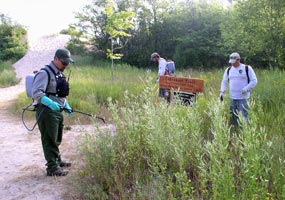|
You are viewing ARCHIVED content published online before January 20, 2025.
Please note that this content is NOT UPDATED, and links may not work. For current information,
visit https://www.nps.gov/aboutus/news/index.htm.
Contact: Bruce Leutscher, 906-387-2680 Contact: Gregg Bruff, 906-387-2607, ext. 208

NPS photo As of 2006, the flora of Pictured Rocks included at least 127 documented exotic plant species representing some 16 percent of all plant species living in the Lakeshore. Some of these were likely introduced to the park as early as the late 1800’s. It is estimated that approximately 20 additional exotic plant species have been introduced or discovered at Pictured Rocks since floristic surveys were conducted in the early 1970’s. Some invasive exotics such as spotted knapweed (Centaurea biebersteinii), blue forget-me-not (Myosotis spp.) and periwinkle (Vinca minor) were noted as common in the park at least 30 years ago. In particular, shade tolerant and highly invasive species present the greatest risks. These aggressive exotic plants are the target of active management which will include physical pulling and spraying. Fortunately, only a small proportion of the lengthy list of non-native plants fall into this category, the majority being “lawn weeds” that are restricted to the road right-of-ways and highly disturbed areas, or plants that although widespread are unlikely to negatively impact native flora or local ecosystems. There is potential for many more exotic plant species to enter the park in the future, and for present populations to increase in number, area covered and density. Several species have spread vigorously due to lack of attention and/or a lack of resources to address them. At least 300 acres of Grand Sable Dunes, a globally rare perched dune ecosystem designated as a Research Natural Area, are now infested with spotted knapweed and red clover (Trifolium pretense). Several plant species of concern are found at Grand Sable Dunes, including Pitcher’s thistle (Cirsium pitcheri), a federally threatened species. Other exotic plants such as goutweed (Aegopodium podagraria) were likely planted by previous landowners in and around buildings and gardens at developed areas (such as Sand Point) and are slowly spreading into undisturbed areas of the forest understory. Additionally, other known exotics are currently found near the park and without continuous monitoring and spot control efforts undoubtedly will spread into the park. A few of the most problematic species found nearby include baby’s breath (Gypsophila paniculata), garlic mustard (Alliaria petiolata), Japanese knotweed (Polygonum cuspidatum) and purple loosestrife (Lythrum salicaria). Exotic plant management is a necessary part of the National Park Service’s responsibility to protect our natural heritage. An exotic plant management program requires both a guiding plan and long-term, steadfast commitment. Short-term lapses can allow populations of invasive species to expand quickly and negate previous control efforts. The threat of exotic species will not disappear. The keys to successful control are a systematic approach and consistent follow-up. Anything less will only provide the park with knowledge of an increasing problem. This summer, Pictured Rocks National Lakeshore will begin an enhanced three-year program to map and control exotic plants. Both mechanical (hand pulling, mowing, cultural control) and chemical control methods will be used extensively to treat exotics and native seed and plants will be used to replant areas when necessary. Some of the exotic species targeted may have showy flowers or leaves that visitors enjoy viewing such as the blue forget-me-not (Myosotis spp.) or goutweed. While visually pleasing, these species are not native to the park and in many cases displace native flower species such as violets (Viola spp.), Jack-in-the-pulpit (Arisaema triphyllum), and trillium (Trillium spp.). If you see park staff spraying vegetation with backpack sprayers or ATV-mounted boom sprayers, it is part of this ongoing program to protect native plants and habitat. For additional information, contact Chief of Heritage Education Gregg Bruff at 906-387-2607, ext. 208, or Ecologist Bruce Leutscher at 906-387-2680. |
Last updated: April 10, 2015
